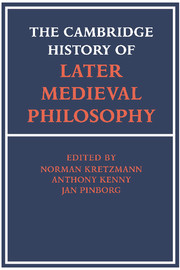 The Cambridge History of Later Medieval Philosophy
The Cambridge History of Later Medieval Philosophy Book contents
- Frontmatter
- Introduction
- I Medieval philosophical literature
- II Aristotle in the middle ages
- III The old logic
- IV Logic in the high middle ages: semantic theory
- 7 The origins of the theory of the properties of terms
- 8 The Oxford and Paris traditions in logic
- 9 The semantics of terms
- 10 The semantics of propositions
- 11 Syncategoremata, exponibilia, sophismata
- 12 Insolubilia
- 13 Speculative grammar
- V Logic in the high middle ages: propositions and modalities
- VI Metaphysics and epistemology
- VII Natural philosophy
- VIII Philosophy of mind and action
- IX Ethics
- X Politics
- XI The defeat, neglect, and revival of scholasticism
- Index nominum
- Index rerum
- References
11 - Syncategoremata, exponibilia, sophismata
from IV - Logic in the high middle ages: semantic theory
Published online by Cambridge University Press: 28 March 2008
- Frontmatter
- Introduction
- I Medieval philosophical literature
- II Aristotle in the middle ages
- III The old logic
- IV Logic in the high middle ages: semantic theory
- 7 The origins of the theory of the properties of terms
- 8 The Oxford and Paris traditions in logic
- 9 The semantics of terms
- 10 The semantics of propositions
- 11 Syncategoremata, exponibilia, sophismata
- 12 Insolubilia
- 13 Speculative grammar
- V Logic in the high middle ages: propositions and modalities
- VI Metaphysics and epistemology
- VII Natural philosophy
- VIII Philosophy of mind and action
- IX Ethics
- X Politics
- XI The defeat, neglect, and revival of scholasticism
- Index nominum
- Index rerum
- References
Summary
A grammatical distinction between categoremata and syncategoremata
The paradigm of the categorical proposition with which medieval logicians were primarily concerned is a sentence of two words that serve as the subject term and the predicate term – e.g., ‘Socrates currit.’ Any word that can be used alone as a subject term or as a predicate term is classifiable as a categorematic word; all other words are classifiable as syncategorematic words, those that can occur in a proposition, whether categorical or hypothetical, only along with at least one properly matched pair of categorematic words – e.g., ‘Solus Socrates currit,’ ‘Socrates currit contingenter’, ‘Socrates non currit’, “Si Socrates currit, Socrates movetur.’ Drawing the distinction between categoremata and syncategoremata along this line, which seems to have been the original line of distinction, produces mutually exclusive and jointly exhaustive classes that coincide almost perfectly with certain groupings of the parts of speech (parts orationis) recognized by medieval grammarians: the names (both substantival and adjectivel), the personal and demonstrative pronouns and the verbs (excluding auxiliary verbs); the syncategoremate are all the others – e.g., the conjunction adverbs, and prepositions.
The logicians' notion of syncategoremata
The notice of synacategoremata that became important in medieval logic was, however, both narrower and broader than that comparatively orderly classification in terms of the parts of speech. Although more than fifty different words were considered in one or another medieval logicians' treatment of syncategoremate, by no means all non categorematic words in even the relatively small classes, such as conjunctions, were of enough interest to the logicians to be treated expressly among their syncategoremata.
- Type
- Chapter
- Information
- The Cambridge History of Later Medieval PhilosophyFrom the Rediscovery of Aristotle to the Disintegration of Scholasticism, 1100–1600, pp. 211 - 245Publisher: Cambridge University PressPrint publication year: 1982
References
- 24
- Cited by
